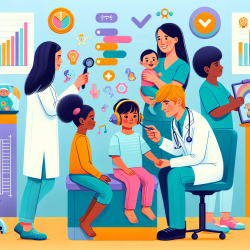Introduction
In the evolving landscape of speech-language pathology, practitioners are constantly seeking innovative interventions to improve language and literacy outcomes for children who are deaf or hard of hearing (D/HH). A recent study titled Study protocol for Hear Me Read (HMR): A prospective clinical trial assessing a digital storybook intervention for young children who are deaf or hard of hearing offers promising insights into a novel digital tool designed to enhance these outcomes. This blog explores the implications of this research and how practitioners can leverage its findings to foster better communication skills in D/HH children.
Understanding the Hear Me Read (HMR) Intervention
The HMR intervention is a digital storybook application designed to complement in-person speech-language therapy for children aged three to five years who are D/HH. This prospective clinical trial, conducted at Nationwide Children's Hospital, aims to assess the efficacy of integrating HMR with traditional therapy. The study hypothesizes that this combination will significantly improve vocabulary, speech, language, and literacy outcomes compared to in-person therapy alone.
Key Findings and Implications
The trial's primary outcome indicates that children using the HMR application alongside traditional therapy show marked improvements in language and literacy skills. Specifically, the intervention aims to:
- Enhance vocabulary acquisition through interactive digital storybooks.
- Provide multimodal language input, catering to the diverse needs of D/HH children.
- Facilitate caregiver-SLP collaboration, promoting a holistic approach to language development.
For practitioners, these findings underscore the importance of integrating digital tools into therapy sessions. By adopting such interventions, SLPs can offer a more engaging and effective therapy experience, potentially bridging the gap between D/HH children and their typically hearing peers.
Practical Applications for Practitioners
Implementing the HMR application in clinical practice involves several key steps:
- Assessment and Customization: Utilize standard assessments to determine each child's specific needs and customize the HMR application accordingly.
- Collaborative Approach: Engage caregivers in the therapy process, encouraging them to use the application at home and provide feedback.
- Ongoing Evaluation: Regularly assess the child's progress using both traditional and digital methods to ensure the intervention's effectiveness.
By following these steps, practitioners can maximize the benefits of the HMR application, fostering significant improvements in language and literacy outcomes for D/HH children.
Encouraging Further Research
While the HMR study presents promising results, it also highlights the need for further research in this area. Practitioners are encouraged to explore additional digital interventions and share their findings with the broader speech-language pathology community. By contributing to the growing body of research, SLPs can help refine and expand the use of digital tools in therapy, ultimately enhancing outcomes for all children with communication challenges.
Conclusion
The Hear Me Read application represents a significant advancement in the field of speech-language pathology, offering a powerful tool to support the language and literacy development of D/HH children. By integrating this digital intervention into their practice, SLPs can provide more effective, engaging, and personalized therapy, paving the way for improved communication outcomes. To delve deeper into the original research, practitioners are encouraged to read the full study by following this link: Study protocol for Hear Me Read (HMR): A prospective clinical trial assessing a digital storybook intervention for young children who are deaf or hard of hearing.










